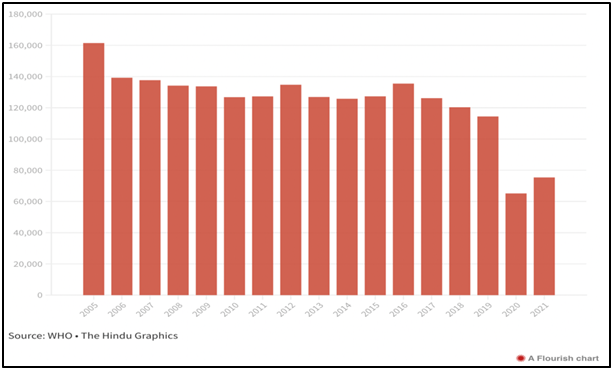India and France deepen ties
Why in news?
- French President Emmanuel Macron visited India as the Chief Guest for the 75th Republic Day celebrations.
- During this visit, India and France made significant decisions with the primary focus on enhancing collaboration in the defence sector.
What’s in today’s article?
- Indo-France Bilateral Relation
- News Summary
Indo-France Bilateral Relations:
- Since the establishment of diplomatic ties in 1948, India and France have enjoyed 75 years of close and friendly relations.
- In 1998, India and France elevated their diplomatic relationship to Strategic Partnership which completed 25 years in January, 2023.
- This Strategic Partnership, first for France outside the EU, has been instrumental in the comprehensive growth of India-France relationship.
Key Pillars of India-France Cooperation:
- Defence Cooperation: The Agreement on Defence Cooperation signed in 2006 and renewed for another 10 years in 2016 gives the framework for all defence cooperation activities between India and France.
- A DRDO office was opened in the Embassy in 2023 for strengthening technology cooperation.
- The procurement of Rafale jets as part of India’s air power is a testament to the deep defence ties.
- Space Cooperation: ISRO and the French Space Agency, CNES have been carrying on various joint research programmes and collaborating in satellite launches.
- For example, on 22 June 2022, GSAT-24 communication satellite of New Space India Ltd (NSIL) was successfully launched on-board Ariane-5 from Kourou, French Guiana.
- Civil Nuclear Cooperation: An agreement on civil nuclear cooperation was signed between India and France in 2008.
- France is involved in the construction of the Jaitapur Nuclear Power Project. However, the progress here has been slow (the first pact was agreed in 2008).
- The two sides have also agreed to establish a partnership on Small Modular Reactors (SMR) and Advanced Modular Reactors (AMR).
- Economic Cooperation: They have important bilateral investments and trade and commercial cooperation, particularly in sectors involving IT corridors, smart-cities, railways, capital and trade exchanges, skill development, etc.
- Bilateral trade reached an impressive $13.4 Bn in 2022-23, marking a significant 7.72% increase from the previous year.
- France has emerged as the 11th largest investor in India, with FDI inflow of $10.5 Bn from April 2000 to March 2023.
- Digital Cooperation: India-France Roadmap on Cyber security and Digital Technologies was one of the outcomes of the visit of the PM of India to France in 2019.
- In July 2023, Unified Payments Interface (UPI) was launched from the Eiffel Tower, offering secure and convenient transactions for Indian visitors and NRIs.
- Culture and Tourism Cooperation: There are many Indo-French cultural associations which organise various events across France.
- For example, the Government of India organised ‘Namaste France’ cultural festival in several cities of France in 2016.
- Marine and Maritime Cooperation: Indo-French Maritime Cooperation is based on the India-France Roadmap on Blue Economy and Ocean Governance adopted in 2022.
- Community in France: The Indian community, including NRIs in mainland France number around 109,000, largely originating from French enclaves of Puducherry, Karaikal, Yanam, Mahe and Chandernagore.
News Summary: India and France deepen ties
- French President Emmanuel Macron was on a two-day State visit to India. He was also the Chief Guest for India’s Republic Day.
- The 2nd Infantry Regiment of the French Foreign Legion also participated in this year’s Republic Day Parade.
- This year, we are celebrating the 25th anniversary of the India-France Strategic Partnership.
- PM Modi was the Guest of Honour at the Bastille Day Parade held on 14 July 2023 in Paris.
Key outcomes of the visit
- Roadmap for India-France Defence Industrial Partnership
- The main goal of this roadmap is to find areas to work together on making military equipment.
- This includes designing, developing, and producing things together, as well as creating supply chains for defence goods between the two countries.
- It aims to foster collaboration in cutting-edge technologies, including robotics, artificial intelligence (AI), autonomous vehicles, platforms, and cyber defence.
- The defence roadmap will cover both air and space technologies, maritime technology, including underwater domain awareness.
- Defence-space partnership
- The two sides also signed a new agreement for a defence-space partnership that will see them collaborate on space situational awareness.
- Airbus-TATA chopper deal
- Tata and Airbus Helicopters have entered into an industrial partnership for the production of H125 helicopters, fostering collaboration in the defence sector.
- Two mega multi-billion-dollar defence deals in the pipeline between the two countries are currently in the cost negotiation phase. These are:
- The 26 Rafale-M fighter jets for the Indian Navy’s aircraft carriers, and
- Three additional Scorpene-class conventional submarines.
- Cooperation in satellite launches
- An MoU was sealed between New Space India Ltd and France’s Arianespace, signifying cooperation in satellite launches and advancing space exploration initiatives.
- Introduction of the Young Professional Scheme
- The scheme facilitates:
- the exchange of individuals between 18-35 years of age, and
- extension of visa validity to five years for Schengen visas for Indian students pursuing master’s degrees in France.
- The scheme facilitates:
- Other areas of cooperation
- Both sides also agreed on cooperation in healthcare, which would include education, training and research, and the use of AI in healthcare.
Key announcements made during the visit
- Year 2026 as the India France Year of Innovation.
- Operationalization of UPI at Eiffel Tower.
- Setting up of a Solar Academy in Senegal under the STAR-C program of International Solar Alliance (ISA).
- STAR-C programme aims to boost solar power ecosystems in the poorest countries.
- The initiative is run by ISA in partnership with the United Nations Industrial Development Organisation (UNIDO).
- Establishment of India’s Consulate in Marseille and French Bureau de France in Hyderabad
